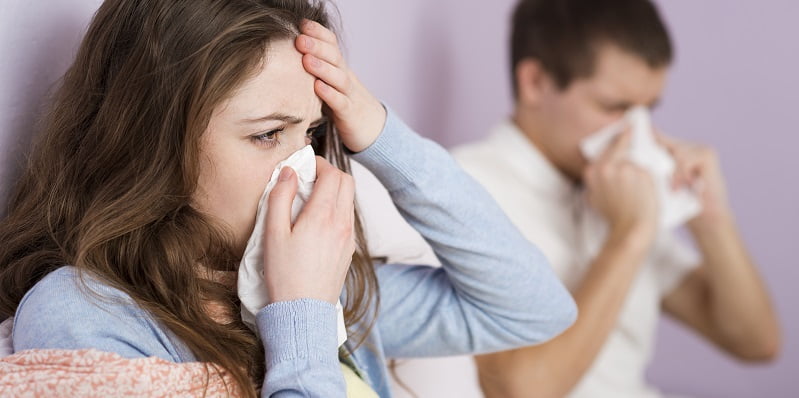Flu, short for influenza, is a viral respiratory illness that affects millions of people worldwide each year. It is characterized by symptoms such as fever, cough, sore throat, muscle aches, and fatigue. While these are the typical signs of the flu, some individuals may also experience back pain during the illness. In this article, we will explore the connection between flu and back pain, understand the underlying reasons, and discover effective ways to alleviate discomfort and promote a faster recovery.
Contents
Understanding the Connection Between Flu and Back Pain

However, someone with the flu can experience back pain indirectly. Here are a few ways this might happen:
- Muscle aches and soreness: As mentioned earlier, body aches and muscle pain are common with the flu. These generalized muscle aches may also affect the muscles in the back, leading to back pain.
- Overexertion: When individuals are sick with the flu, they may try to compensate for their weakened state by using different muscles to perform tasks, including the back muscles. This can lead to strain and back pain.
- Prolonged bed rest: Some people with the flu may spend prolonged periods lying in bed to rest, which can put a strain on the back and lead to discomfort or pain.
- Pre-existing conditions: If a person has a pre-existing back condition, such as a herniated disc or muscle strain, the flu’s general weakness and fatigue can exacerbate the back pain.
It is crucial to note that if you or someone you know is experiencing severe or persistent back pain along with flu-like symptoms, it’s essential to seek medical attention promptly. While most cases of the flu resolve on their own with rest and proper care, severe complications can occur, and back pain can sometimes be a sign of other underlying health issues that require evaluation and treatment.
The Role of Immune Response in Flu and Back Pain
The immune system plays a crucial role in combating the flu virus.
- Immune response in the flu: Influenza is caused by the influenza virus, and when the virus enters the body, the immune system recognizes it as foreign. The immune system then mounts a response to fight off the virus and prevent it from spreading.
This immune response is what leads to the typical symptoms of the flu, such as fever, body aches, and fatigue. The immune system produces cytokines (small proteins) that signal other immune cells to target and destroy infected cells. These cytokines can cause inflammation, contributing to muscle aches and general discomfort.
- Back pain and the immune system: Back pain can have various causes, and the immune system can be involved in some cases. For instance, back pain may occur due to inflammation of the muscles or soft tissues in the back, and this inflammation can be a result of the immune system’s response to injury, infection, or autoimmune conditions (where the immune system mistakenly attacks the body’s tissues).
Posture and Muscular Tension During Flu

During the flu (influenza), your body is fighting off the viral infection, and this can lead to various symptoms, including changes in posture and muscular tension. Here’s how the flu can affect posture and cause muscular tension:
- Muscle aches and soreness: Muscle aches and general body soreness are common symptoms of the flu. The muscles throughout your body may feel tender and achy due to the body’s immune response and inflammation caused by the virus. This discomfort can affect your posture as you may try to find positions that alleviate the pain, leading to changes in how you stand, sit, or move.
- Fatigue and weakness: The flu can cause extreme fatigue and weakness as your body devotes energy to fighting off the infection. This fatigue can impact your muscles, making them feel weaker and less capable of supporting your body in an optimal posture. As a result, you might find yourself slouching or adopting less-than-ideal postures to conserve energy.
- Prolonged bed rest: When experiencing the flu, many people spend a lot of time in bed to rest and recover. Prolonged bed rest can lead to muscle stiffness and decreased flexibility. Additionally, being in one position for too long, such as lying down, can cause the muscles to become tense and may lead to discomfort when trying to resume a more upright posture.
Bed Rest and Back Pain
Bed rest can be both beneficial and potentially harmful when it comes to back pain, depending on the specific circumstances and underlying causes of the pain. Let’s explore both aspects:
Beneficial effects of bed rest:
- Reduced stress on the back: Lying down in a comfortable position can reduce the pressure on the spine and alleviate stress on the back muscles, discs, and other structures.
- Time for healing: Resting allows the body to focus its resources on healing and repairing any injured or inflamed tissues in the back.
- Pain relief: In some cases, especially if the back pain is acute and caused by a recent injury or strain, short-term bed rest can provide pain relief.
Potential harmful effects of bed rest:
- Muscle weakness: Prolonged bed rest can lead to muscle deconditioning and weakness, which may worsen back pain in the long run. Weak muscles can provide inadequate support for the spine and contribute to poor posture.
- Stiffness and reduced flexibility: Staying in bed for too long can result in stiffness and reduced flexibility, making it harder to resume normal activities when you start moving again.
- Pressure on the spine: Staying in one position for an extended period, especially if it involves poor posture, can put pressure on certain areas of the spine and exacerbate back pain.
Exercise and Its Importance in Recovery
Here are some reasons why exercise is important in the recovery process:
- Strengthening muscles: Specific exercises can target and strengthen the muscles surrounding the affected area, providing better support for the spine and reducing the risk of future injuries.
- Improving flexibility and mobility: Gentle stretching and mobility exercises can help increase flexibility and range of motion, reducing stiffness and discomfort in the affected area.
- Promoting circulation: Exercise increases blood flow to the affected area, which can aid in the healing process by delivering oxygen and nutrients to the tissues and removing waste products.
- Releasing endorphins: Physical activity triggers the release of endorphins, which are natural painkillers and mood enhancers. This can help reduce pain perception and improve overall well-being during the recovery period.
- Preventing deconditioning: Prolonged bed rest or inactivity can lead to muscle deconditioning and weakness, potentially prolonging the recovery process. Regular exercise helps prevent this deconditioning and maintains muscle strength.
Preventing Flu-Related Back Pain

While the flu (influenza) itself does not directly cause back pain, some precautions can be taken to prevent back pain or minimize discomfort during the flu or any other viral illness. Here are some tips:
- Practice good hygiene: Wash your hands regularly with soap and water, especially after coughing, sneezing, or being in public places. This helps reduce the risk of contracting the flu virus or other infections that might cause muscle aches or back pain.
- Get vaccinated: Consider getting an annual flu vaccine to lower your chances of contracting the flu in the first place.
- Maintain a healthy lifestyle: A balanced diet, regular exercise, adequate sleep, and stress management all contribute to a robust immune system and overall well-being, reducing the risk of catching the flu or experiencing complications that may lead to back pain.
- Stay active: Regular physical activity can help keep your muscles and joints in good condition, reducing the risk of back pain. Consult with your doctor or a physical therapist for appropriate exercises, especially if you have a history of back issues.
- Practice proper posture: Be mindful of your posture when sitting, standing, or lifting objects. Maintaining good posture can help prevent strain on your back muscles and reduce the risk of developing pain.
Alternative Therapies for Relief
Always consult with a healthcare provider before trying any alternative therapy, especially if you have underlying health conditions or are taking medications. Here are some alternative therapies that people often explore for relief:
- Acupuncture: Acupuncture is an ancient Chinese practice that involves the insertion of thin needles into specific points on the body. It is believed to stimulate the body’s natural healing processes and promote pain relief. Some studies have shown that acupuncture may help reduce back pain and improve mobility.
- Chiropractic care: Chiropractors use manual manipulation techniques to adjust the spine and other joints, aiming to improve alignment and alleviate pain. Chiropractic care may be helpful for certain types of back pain, but it’s essential to consult a licensed and experienced chiropractor.
- Massage therapy: Massage can help relax tense muscles and reduce muscle spasms, providing temporary relief from back pain. It may also promote relaxation and reduce stress.
Conclusion
In conclusion, the flu and back pain are interconnected due to the body’s immune response and inflammation. Taking proactive measures such as maintaining good posture, engaging in light exercises, and following a nutritious diet can ease back pain and promote faster recovery during the flu. Remember, seeking professional medical advice and adopting preventive measures can play a significant role in staying healthy during flu season.
If you’re experiencing Back pain, physical therapy for back pain at PhysioMantra can help: Book an online physical therapy session.



